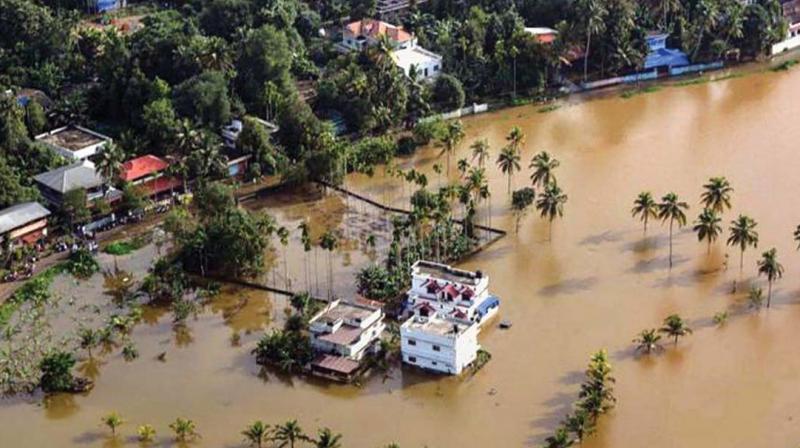Together, we can dam the destruction
Our track record in managing floods around heavily dammed rivers, inter-state or otherwise, has been poor.

The devastating floods in Kerala have hardly begun their retreat, but the flood of empathy and cooperation seems to be receding already and being replaced with blame games. The Kerala government is blaming Tamil Nadu’s refusal to reduce the storage in its Mullaperiyar dam in anticipation of the heavy rain and the sudden release of water from it for the flooding of the Idukki valley and areas downstream of it. But Tamil Nadu has countered saying it was Kerala which had refused it permission to gauge the rainfall in the Mullaperiyar dam catchment and it had a right to retain water in the dam upto 142 ft. It contends that water from Kerala’s own independent catchment areas and the sudden release of water from the Idukki hydro-electric dam is the main cause of the flooding.
Following these arguments by the two states, the Supreme Court asked the disaster management sub-committee of the Mullaperiyar dam to look into the matter and it has recommended reducing its water level to 139ft, indirectly vindicating Kerala's stand. But isn’t this a case of too little too late? What was the sub-committee doing when the heavy rain began? Can a system so dependent on the Supreme Court be functional during an emergency? Shouldn’t we have more robust mechanisms for managing riparian issues in real-time?
Our track record in managing floods around heavily dammed rivers, inter-state or otherwise, has been poor. Consider the 2009 floods in the Krishna river basin in North Karnataka and Andhra Pradesh. The heavy rain received between September and October that year resulted in unprecedented flooding of the many semi-arid regions of both states and Andhra Pradesh accused Karnataka of releasing water from its Almatti and Narayanpur dams without adequate notice. At the time, our study pointed to delays in communication between the meteorological departments and dam managers of the two states. A detailed analysis of reservoir operations also showed that the flooding in Kurnool town could have been reduced if water levels downstream of the Srisailam dam had been lowered in anticipation of heavy inflows. The temptation to hold on to as much water as possible in order to meet normal irrigation and hydro-power needs got the better of caution in a distress situation.
Weak mechanisms, unchanged mindsets
Unfortunately, most inter-state basins do not have joint supervisory committees to communicate and coordinate dam releases during heavy rain. Even when they do, as in the case of the Cauvery or the Periyar rivers, they do not seem to be able to respond effectively to sudden heavy rainfall and floods. The failure of the disaster management sub-committee for Mullaperiyar to respond with the urgency required in the present situation is a case in point.
Moreover, as the Srisailam case shows, reservoir operations remain driven by the old mindset of “filling the dam for future use” rather than creating a flood cushion to avoid immediate disasters. Then at the last minute it becomes all about “save the dam at all costs.” The CAG’s report on the 2015 Chennai floods said that excessive release from the upstream tanks was a major contributor and that the rules for operation of the tanks had not been updated for 23 years, not even after the 2005 floods. Add to this the inter-state one-upmanship and lack of communication in a situation where climate change is resulting in more extreme events, and you have a recipe for disaster.
Cooperate, Delegate and Anticipate
Going forward, several steps seem essential. First and foremost, states with trans-boundary rivers must recognize these disasters as a common humanitarian challenge and create coordination committees without needing to be prompted by the Supreme Court. Otherwise, even when created, these committees will not really function. Can we see reverse one-upmanship, where states take a more cooperative approach like Tamil Nadu and Karnataka did by offering aid to Kerala this time? Second, these committees need to function with some autonomy. Their terms of reference must mention full authority to direct dam operations upstream and downstream during extreme events. States must declare the onset of such events and delegate authority, resisting the temptation for micro-management for narrow political ends. What is equally important is that these committees need to work together during quieter times to build trust between them. Only continuous interaction and decision-making will build understanding of the system and trust.
Finally, states need to make the effort to generate and make available the best data and flow modelling/forecasting models to these committees and individual dam operators, and carry out a periodic scrutiny of reservoir operation rules. Having data is not to be confused with making data available and usable! For instance, Karnataka boasts of the greatest density of rain gauges, thanks to its investment in the state Natural Disaster Monitoring Centre and its gram panchayat-level rain gauge network, but the interface between the NDMC and the irrigation department is poor, and the data is not fully in the public domain or integrated with that which is generated by the irrigation department. Nor is the irrigation department proactively analysing the link between rainfall and river flows to see how this relationship may be changing. Making all this data public will, at least, ensure that research groups make some of these connections and help the supervisory committees do their job. With climate change increasing the frequency of extreme rain events, we need concerted and cooperative effort to operate our dams in ways that mitigate, not aggravate their impact.
The authors are interdisciplinary scientists at the Centre for Environment and Development, ATREE, Bengaluru.

